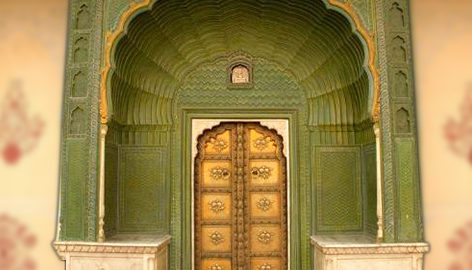

Settlement and farming lead to great development in human history. The gradual progress increased the necessity of protection which further resulted in fortification. The first fortified city was the Proto-city of Jericho and since then fortification became an important part of many major cities in the world. The main aspects of fortification are the grand doors that help these fortified towns to supervise, cooperate and protect. According to the literary sources like Arthashastra and Adnyapatra, a door should be made at the weakest part of any fortified city or a fort so it can be well protected. In the later period as the trade developed and larger cities started forming these door became more important, sometimes is also became the status symbol. The best examples of this statement are the doors established during the medieval period in India. The prominence and beauty of these doors are so incredible that they are still the part of many cities as the symbol of the glories past. These marvellous entrances are also illustrated on ‘Doors on stamp’ series by India Post in 2019. Let have a quick glance through this beautiful heritage…
Roomi Darwaza, Lucknow:
In 1784, under the patronage of Nawab Asaf-ud-duala the marvellous and magnificent Roomi Darwaza, also known as Turkish gate, was constructed. It is a classic example of Awadhi architecture due to the Mughal influence. This structure is the symbolic logo of the ethic city of Lucknow.
Roomi Darwaza is sixty feet tall structure and the modelled after the Bab-i-Humayun –a sublime port in Istanbul. This Darwaza marked the entrance of the old city of Lucknow but as the city grew it was used as the entrance of the Palace which was later demolished by the British.
It is widely assumed that the term Rumi was adopted from Jala-ad-Din Muhammad Rumi a 13th century Muslim Sufi mystic. This massive gate is suited between Bara Imambara and ChotaImambara.
In 2019, India post issued a set of commemorative stamps series ‘Doors on stamp’ illustrating the gates of India. The five rupee stamp depicts this magical classic of Lucknow.
Kote Gate, Bikaner:
The medieval Bikaner was a well-protected city with its huge walls and magnificent Gates. The protection around Bikaner was similar to the fortified cities of Rajasthan. The remains of old Bikaner is still there in the form of Kote Gate.
The gate that was created by the intrinsic and strong architecture technique is still standing after five hundred years. This gate was built during the reign of Raja Ganga Singh. The word “Kote”was taken from the word ‘Parkote’ meaning ‘Wall of the City for its protection’.
It is also interesting to note that the kote gate is the centre point for both the New Bikaner and old Bikaner city.
India Post depicts this medieval beauty of the Five rupee stamp which is issued as part of the series called ‘Doors on stamp’ in 2019.
Magazine Gate, Ajmer:
The main gate leading to the Akbar’s palace! The magazine building created by Emperor Akbar in 1570 AD is the Magazine Gate. It is said that Emperor Akbar stayed in this place during his visit to Dargah of KhwajaSaheb. In 1818 AD the palace was taken over by the British East India Company form The Maratha kingdom and was used as the arsenal ground due to which it got its name as the Magazine building.
According to the historical records Prince Salim, later Emperor Jahangir, issued the Farman permitting the British East India Company to trade with India from this place. This symbolic gate is made with sandstone and has an essence of the Mughal architecture in it. The State Government of Rajasthan has converted this place into Rajputana Museum.
To commemorate this beautiful monument, India Post issued a stamp in the series ‘Doors on stamp’ in 2019.
Buland Darwaza, FatehpurSikri
The main gate of the Jama Majiz in Fatehpur Sikri is the powerful-looking famous Buland Darwaza. It was built by the Mughal Emperor Akbar to commemorate his victory over Gujarat. This Darwaza (door) is approached by 42 steps and 53.63m high and 35-meter wide area. This structure is made of red and black buff sandstone. The ornamentation of this structure is done by carving and inlaying on the white and black marble. The central part of DulandDarwaz also consists of an inscription of Emperor Akbar.
This structure is octagonal in plan and is topped by pillar and chhatris with simple ornamentation of carved verses of Koran. There is also a later inscription on the eastern archway of BulandDarwaza recording Akbar’s conquest over Deccan in 1601 AD.
In the same series ‘Doors on stamp‘, India post issued a stamp illustrating the beautiful and magnificent BulandDarwaza in 2019.
India Post has tried its best to depict all the major doors on stamp. The main motive behind the series is to commemorate and promote the rich heritage of India. These series consist of many other stamps which we will discuss in detail in our next instalment. Wait for the next epic analysis till then keep collecting…
The Mintage World Team comprises of experts, researchers and writers from the field of Philately, Notaphily and Numismatics who try to shed light on some of the most interesting aspects of coins, banknotes and stamps from not just India but across the globe as well.